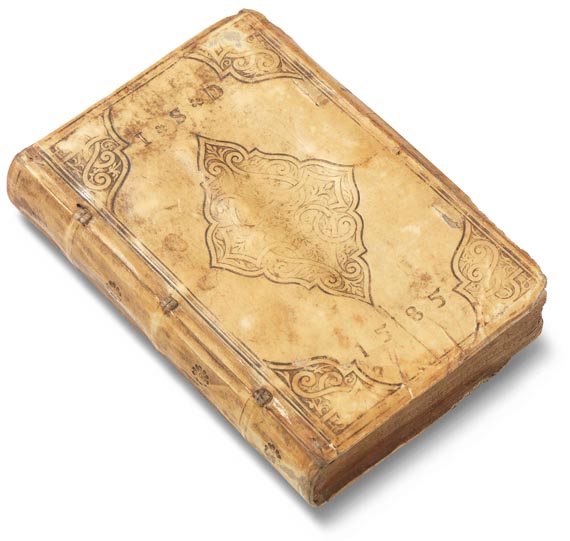
(incl. surcharge)
Outstanding Album Amicorum of the Danzig mayor, merchant, patron and collector Johann Speimann (also: Speymann or Speimann von der Speie), who went on a prolonged journey to Italy after he had completed his studies in Cracow. Besides those places mentioned in this book, he stayed in Königsberg, Wittenberg, Strasbourg, Padua, Pisa and Siena. Back in Danzig, he established trade connections, mostly with Italy that he supplied with grain by ship, as Italy was suffering under bad harvests. Another journey to Venice in 1592 increased his connections even more, as he was ennobled by pope Clement VIII. for his help for the starving Italians. Danzig owes the wealthy merchant numerous monuments, among them the famous Speimann House, which is also called Goldene Haus (Golden House) for its rich gilt decorations. He was councilman since 1603, and from 1612 up until his death in 1625 he was Danzig's mayor (cf.: M. Bogucka, Die Kunstförderung in Danzig - Hans Speiman, seine Sammlung und seine Stiftung. In: Bürgertum und Kunst in der Neuzeit. Published by H. U. Thamer. Cologne 2002. Pp. 115-124).
The splendid decoration with armorial watercolours is in line with the large number of important people, who had written into his book. The entry by the artist Thomas Schweicker from Schwäbisch Hall (1540-1602), is a particularly remarkable piece, as he did not have arms and wrote the entry by means of his feet. Despite this handicap, he was able to make a living as a calligrapher. Even though Schweicker was quite famous in those days, attracting many visitors to Schwäbisch Hall, in order to acquire his works, even though emperor Maximilian II. was among those interested in his art, autographs by his hand or rather his foot are extremely rare (our inquiry has not found proof of a singly item on the auction market). He wrote for Speimann: "Dem Edlen und Vesten Junkherrn Hannsen Speiman zu ehren und wolgefallen hab Ich Thomas Schweicker zu Sch. Hall, diß mit meine(n) füsse(n) geschrib. Den 19ten May A(nn)o 1585 ..." (on Schweicker cf. Thieme/B. and Nagler).
With entries by: Conrad von Zedlitz, Hans von Wolfskehl und Andreas Ernst von Wolfskehl, Georg Sigmund von Wiesenthau, Philipp Im Hoff, Hans Jacob Haller von Hallerstein, Lorenz Spengler, Georg Graf von Sayn-Wittgenstein; Anton von dem Streithorst (statesman, cf. ADB); Bartholomäus Wagner, Wenzeslaus Mittendorff, Christoph von Hacke, Heinrich Gyse, Moritz von Oeynhausen, Alexander Gysi, Georg Clefeldt, Abraham Kynast, Wolfgang Pogwisch, Viktor von Althan, Wilhelm Raitz von Frentz, Wolfgang Christoph (Reichserbmarschall von Pappenheim), Peter Grabsky, Georg Sebastien Stieber; Johannes von Heerma, Wolfgang and Heinrich von Ende, Heinrich von Schönberg, Georg Ermiens Perger von Clamb, Augustin Koeckert (jurist), Asmus von Buttlar, Laurentius Müller, Christoph Hunicke, Heinrich von Gittelde, Apitzius von Grunenberg, Barthold von Gadenstedt (playwright, cf. ADB), Claus and Nikolaus von Below (entries in Greek), Johannes Schröter, Johannes von Sokolowsky, Adrian Rhambowius, Stanislaus und Felix von Konarzin, Stephan and Johannes Loytz (well-known merchant family, cf. ADB), Georg and Heinrich Kleefeld (sons of the well-known politician Georg Kleefeld, each with coat of arms), Vincent and Johannes Moller (sons of the Hamburg mayor Eberhard Moller; Johannes was also mayor as of 1599; cf. Schröder 2661 and 2673); Arnold von Holden, Paul Kochansky, Hector Griebel, Briccius von Kinberg; Wilhelm Sitzinger aus Nürnberg, Damasus van Blyenburg (Dutch poet); Georg von Saurma, Hoier Gartz, Martin Kuttowitz, Erasmus Moritz from Magdeburg, Theodor Sigismund Curio from Heidelberg, Caspar Cojus from Prussia, Friedrich Dasypodius (prof. in Helmstedt), Daniel Eggebrecht from Wismar, Urbanius Quisard, Johannes Fuchs aus Onolsberg, Zacharias Textor, Daniel Placotomus, Valentin Thilo (jurist).
The front pages of the first 9 ll. contain an alphabetical register of entries, autographed by Speimann, partly with Latin quotations on rear, also written by his hand. Pastedowns also signed by Speimann. - Attached is a manuscript index by the former owner baroness Elise Kressig-Warthausen (same format, together with the album amicorum in slipcase). - Corners of binding with traces of worming, gilt tooling faded, else well-preserved.
Outstanding Album Amicorum of the merchant and art collector Johann Speimann, famous mayor of Danzig from 1612 up to his death in 1625, owner of the town's most attractive Renaissance mansion, the so called Golden House. 172 leaves with 87 entries from Genf, Heidelberg, Basle and Danzig in 1585-1588, written during Speiman's educational journey to Italy. Containing 36 magnificent coat of arms in watercolour. With an alphabetical index by Speimann's own hand at the beginning, interspersed with some Latin quotations, his signature on the pastedown. Contemp. vellum with gilt ornaments, Speimann's monogram and date '1585', as well as gauffered gilt edges (corners with damage by mice, gilt tooling faded). Size 16,5 : 11 cm. - Among the entries are many noblemen, merchants and scholars. A rarity are the lines by the armless calligrapher Thomas Schweicker in Schwäbisch Hall (famous in his time and visited even by emperor Maximillian II.) which he has written with his foot. - Attached an manuscript index by the former owner baroness Elise Kressig-Warthausen (bound in same size, together with the Album in a marbled slipcase). Well-preserved.
(incl. surcharge)
Headquarters
Joseph-Wild-Str. 18
81829 Munich
Phone: +49 89 55 244-0
Fax: +49 89 55 244-177
info@kettererkunst.de
Louisa von Saucken / Undine Schleifer
Holstenwall 5
20355 Hamburg
Phone: +49 40 37 49 61-0
Fax: +49 40 37 49 61-66
infohamburg@kettererkunst.de
Dr. Simone Wiechers / Nane Schlage
Fasanenstr. 70
10719 Berlin
Phone: +49 30 88 67 53-63
Fax: +49 30 88 67 56-43
infoberlin@kettererkunst.de
Cordula Lichtenberg
Gertrudenstraße 24-28
50667 Cologne
Phone: +49 221 510 908-15
infokoeln@kettererkunst.de
Hessen
Rhineland-Palatinate
Miriam Heß
Phone: +49 62 21 58 80-038
Fax: +49 62 21 58 80-595
infoheidelberg@kettererkunst.de
We will inform you in time.




 Lot 4
Lot 4 